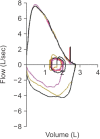Spirometry and Bronchodilator Test
- PMID: 28416951
- PMCID: PMC5392482
- DOI: 10.4046/trd.2017.80.2.105
Spirometry and Bronchodilator Test
Abstract
Spirometry is a physiological test for assessing the functional aspect of the lungs using an objective indicator to measure the maximum amount of air that a patient can inhale and exhale. Acceptable spirometry testing needs to be conducted three times by an acceptable and reproducible method for determining forced vital capacity (FVC). Until the results of three tests meet the criteria of reproducibility, the test should be repeated up to eight times. Interpretation of spirometry should be clear, concise, and informative. Additionally, spirometry should guarantee optimal quality prior to the interpreting spirometry results. Our guideline adopts a fixed normal predictive value instead of the lower limit of normal as the reference value because fixed value is more convenient and also accepts FVC instead of vital capacity (VC) because measurement of VC using a spirometer is impossible. The bronchodilator test is a method for measuring the changes in lung capacity after inhaling a short-acting β-agonist that dilates the airway. When an obstructive ventilatory defect is observed, this test helps to diagnose and evaluate asthma and chronic obstructive pulmonary disease by measuring reversibility with the use of an inhaled bronchodilator. A positive response to a bronchodilator is generally defined as an increase of ≥12% and ≥200 mL as an absolute value compared with a baseline in either forced expiratory volume at 1 second or FVC.
Keywords: Bronchodilator Agents; Guideline; Lung; Spirometry.
Conflict of interest statement
Conflicts of Interest: No potential conflict of interest relevant to this article was reported.
Figures




References
-
- The BTS COPD Consortium. Spirometry in practice. A practical guide to using spirometry in primary care. 2nd ed. London: The BTS COPD Consortium; 2005.
-
- The Korean Academy of Tuberculosis and Respiratory Diseases. 2016 Guideline of pulmonary function test [Internet] Seoul: The Korean Academy of Tuberculosis and Respiratory Diseases; 2016. [cited 2016 Nov 1]. Available from: http://www.lungkorea.org/bbs/index.html?code=guide&category=&gubun=&page...
-
- Gold WM, Koth LL. Chapter 25. Pulmonary function testing. In: Broaddus VC, Mason RJ, Ernst JD, King TE, Lazarus SC, Murray JF, et al., editors. Murray and Nadel's textbook of respiratory medicine. 6th ed. Philadelphia: Saunders/Elsevier; 2015. pp. 407–435.e18.
-
- Miller MR, Crapo R, Hankinson J, Brusasco V, Burgos F, Casaburi R, et al. General considerations for lung function testing. Eur Respir J. 2005;26:153–161. - PubMed
-
- Miller MR, Hankinson J, Brusasco V, Burgos F, Casaburi R, Coates A, et al. Standardisation of spirometry. Eur Respir J. 2005;26:319–338. - PubMed
Publication types
LinkOut - more resources
Full Text Sources
Other Literature Sources

